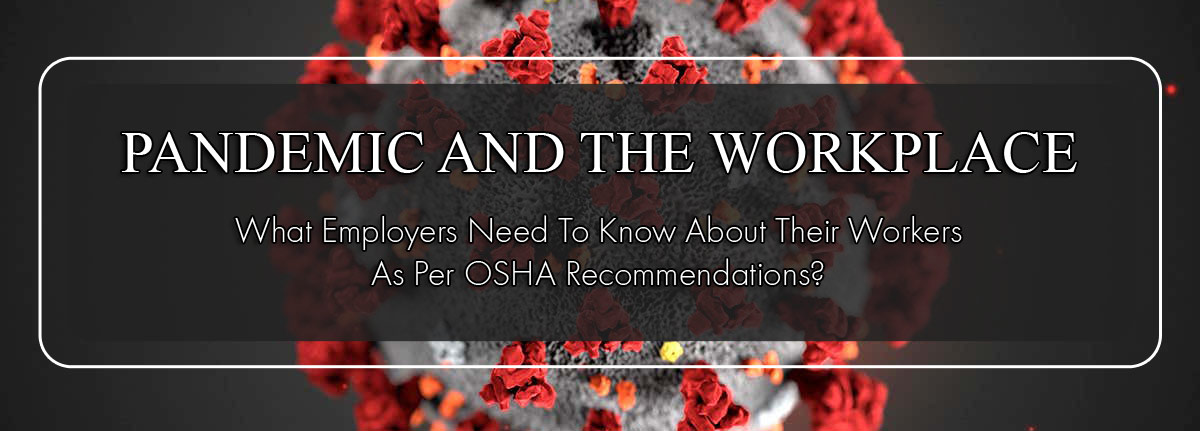
Pandemic And The Workplace, What Employers Need To Know About Their Workers As Per OSHA Recommendations?
As we all know that our lives are getting curtailing, and we have to consider now for our future plans so that we can plan a safe and healthy workplace environment. KRM CORPORATION/ KRM Safetech Private Limited (KRM LOTO Lock Tag!! Safe loto) helps you with various proven industrial lockout/tag-out safety and identification solutions that can increase your efficiency once the pandemic has gone.
Shutdown and maintenance of plants and equipment are for human safety who actually works on these machines. Some basic necessities like Masks, Hand Gloves, Sanitizer and a proper arrangement to dispose-off the same should be made by the enterprises by purchasing these items as per the OSHA Recommendations to
- Control and Prevention
- Hazard Recognition
- Medical Information
- Standards
- Protecting Workers during a Pandemic
- Guidance on Preparing Workplaces for COVID-19
1. Control and Prevention
Necessary steps for protecting the workers from novel coronavirus, COVID-19 depends upon the work being performed and the risk of getting this virus. And the same can be done by taking proper preventive measures like:
Properly and frequently wash hands with soap and water for at least 20 seconds and if the soap is not available then go for an alcohol-based sanitizer which should contain a minimum of 60% alcohol content
Avoid touching your eyes, face and nose with unwashed hands and also try to avoid close contacts with the infectious person.
And if you find any person with this virus then take necessary steps to isolate them so that they cannot transmit to others.
Disinfect the surfaces on workplaces frequently and regularly.
Workers who conduct cleaning tasks must be protected from exposure to blood, certain body fluids, and other potentially infectious materials covered by OSHA’s Bloodborne Pathogens standard (29 CFR 1910.1030) and from hazardous chemicals used in these tasks. In these cases, the PPE (29 CFR 1910 Subpart I) and Hazard Communication (29 CFR 1910.1200) standards may also apply. Do not use compressed air or water sprays to clean potentially contaminated surfaces, as these techniques may aerosolize infectious material.
Workers required to use PPE must be trained. This training includes when to use PPE; what PPE is necessary; how to properly don (put on), use, and doff (take off) PPE; how to properly dispose of or disinfect, inspect for damage, and maintain PPE; and the limitations of PPE. Applicable standards include the PPE (29 CFR 1910.132), Eye and Face Protection (29 CFR 1910.133), Hand Protection (29 CFR 1910.138), and Respiratory Protection (29 CFR 1910.134) standards. The OSHA website offers a variety of training videos on respiratory protection.
When the potential exists for exposure to human blood, certain body fluids, or other potentially infectious materials, workers must receive the training required by the Bloodborne Pathogens (BBP) standard (29 CFR 1910.1030), including information about how to recognize tasks that may involve exposure and the methods, such as engineering controls, work practices, and PPE, to reduce exposure. Further information on OSHA's BBP training regulations and policies is available for employers and workers on the OSHA Bloodborne Pathogens and Needlestick Prevention Safety and Health Topics page. Read More info about control and prevention.
2. Hazard Recognition
This virus can be recognized when a person is having a breathing problem and can spread between persons via respiratory secretions when they cough or sneeze. It can also get transmitted when an infectious person maintains a close contact that is less than 6 meters with a non-infectious person. The secretion from the respiratory system gets into the mouth or nose of other person and after that, it enters in the lungs making the other person also sick.
OSHA standards, including those for personal protective equipment (PPE, 29 CFR 1910.132) and respiratory protection (29 CFR 1910.134), requires employers to assess the hazards to which their workers may be exposed.
In assessing potential hazards, employers should consider whether or not their workers may encounter someone infected with COVID-19 in the course of their duties. Employers should also determine if workers could be exposed to environments (e.g., worksites) or materials (e.g., laboratory samples, waste) contaminated with the virus.
Depending on the work setting, employers may also rely on the identification of sick individuals who have signs, symptoms, and/or a history of travel to COVID-19-affected areas that indicate potential infection with the virus, in order to help identify exposure risks for workers and implement appropriate control measures. Read more about Hazard recognition.
3. Medical Information
The novel coronavirus, COVID-19 is one of seven types of known human coronaviruses. COVID-19, like the MERS and SARS coronaviruses, likely evolved from a virus previously found in animals. The remaining known coronaviruses cause a significant percentage of colds in adults and children, and these are not a serious threat for otherwise healthy adults.
Patients with confirmed COVID-19 infection have reportedly had mild to severe respiratory illness with symptoms such as fever, cough, and shortness of breath. Read more about Medical Information
4. Standards
There is no specific OSHA standard covering COVID-19. However, some OSHA requirements may apply to prevent occupational exposure to COVID-19. Among the most relevant are:
- The General Duty Clause, Section 5(a)(1) of the Occupational Safety and Health (OSH) Act of 1970, 29 USC 654(a)(1), which requires employers to furnish to each worker “employment and a place of employment, which are free from recognized hazards that are causing or are likely to cause death or serious physical harm.”
- OSHA's Personal Protective Equipment (PPE) standards (in general industry, 29 CFR 1910 Subpart I), which require using gloves, eye and face protection, and respiratory protection. When respirators are necessary to protect workers, employers must implement a comprehensive respiratory protection program in accordance with the Respiratory Protection standard (29 CFR 1910.134). Read more about Standards
5. Read about Protecting Workers during a Pandemic
6. Guidance on Preparing Workplaces for COVID-19
Read Original Source here -
https://www.osha.gov/SLTC/covid-19/controlprevention.html

